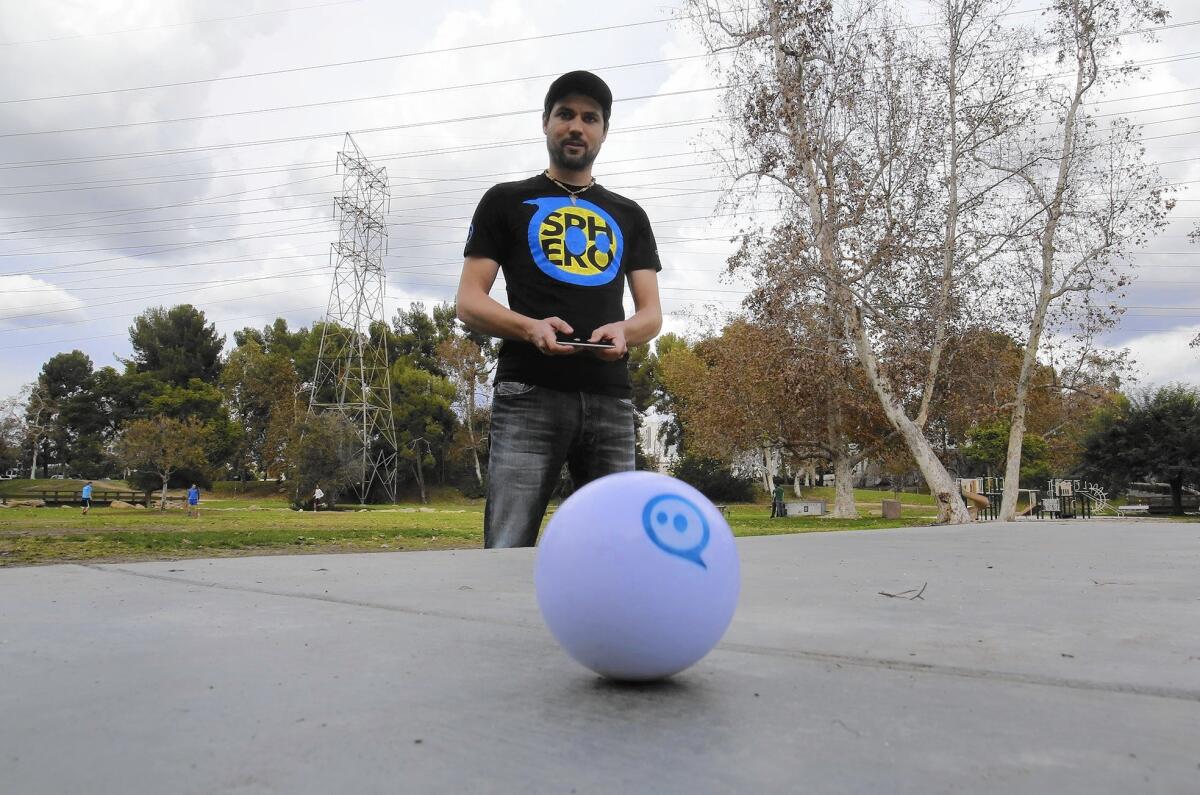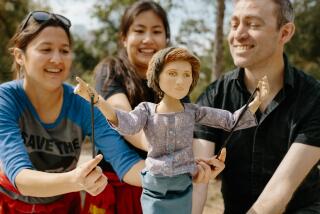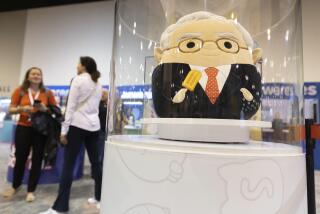Software upgrades re-create old-school toys as smart playthings

Balls. Dolls. Race cars. So dull.
How can good old-fashioned toys like these compete for children’s attention when the kids seem umbilically connected to their iPads?
How about software-upgradable balls, dolls and race cars?
Established toy makers and entrepreneurs from outside the toy industry are creating a new generation of connected toys. Just as software updates pulse new life into years-old smartphones and tablets, so too for kids’ playthings. Equipped with Wi-Fi or Bluetooth, the toys can be customized, personalized and improved through the Internet to make them just as dynamic as tablets.
“The world of imagination coupled with your phone is the new reality for toys,” said Adam Wilson, chief software architect at connected-toy maker Sphero. “Playing with plastic is just not enough today.”
Sphero’s pitch to parents is simple. No kid will be chasing after his or her iPad or tossing it like a Frisbee (well, hopefully). To get children to move more than their fingers and to hang out with friends, Sphero is offering toys juiced with software.
Sphero sells cylindrical and spherical polycarbonate toys controlled by smartphone and tablet apps that kids can race, light up, toss as a fetch toy or roll down the living room like a bowling ball. They start at $99.
If imagination alone doesn’t lead to a cool use, Sphero provides more than 30 apps that interact with its products. One app turns Sphero into a measuring tape. Another, a digital hot potato. In games, the gadgets become controllers to be tilted and turned similar to waving a Nintendo Wii remote. Players also have the option of writing their own code and apps.
“We’re at stage 1 of 150 stages to make a whole new experience for people,” Wilson said.
Four years ago, he and fellow Sphero co-founder Ian Bernstein came together to develop software for robots. But the robots were too clunky to do anything fun with. Wilson and Bernstein branched into hardware development and produced a robot that was no more than a ball.
“It’s a minimally viable robot, but it’s a dot that can become anything,” Wilson said.
In line with most of today’s connected toys, new apps and software updates for Sphero are free. Consumers pay a higher price for the toy itself. But toy makers say the premium pays off since children so far have held on to them longer than traditional products.
Toys have been going high-tech in spurts for two decades as the cost of the latest consumer technology drops to a point where it can be included in typically inexpensive children’s toys. But the latest wave is notable for two reasons: It’s aimed at parents who fret about the downsides of iPad fixation, while leveraging some of the same technology inside smartphones and tablets to encourage more active play.
“The toy industry always reflects the culture at large,” said industry analyst Chris Byrne. “We turn to technology a great deal for entertainment as adults, so it would make sense children would too.”
Pramod Sharma, who as an engineer at Google developed a machine to scan copies of books, watched his preschool-age daughter Saanvi spend hours at a time on an iPad unless he stepped in.
Growing up, Sharma, 34, joined friends in building sandcastles and toy-block structures along the rivers of northern India. To give his daughter an opportunity to find similar camaraderie, he returned to his expertise in helping computers “see.”
Sharma and a fellow former Google engineer developed an $80 play set called Osmo. Children place the iPad on a stand and affix a small mirror to the iPad so the camera can pick up on what’s lying in front of the stand. One of three initial games revolves around tiny squares stamped with letters. Children must arrange letters to form the word for an on-screen image, and the screen lights up when the arrangement is correct.
Osmo’s “computer vision” technology also has the smarts to recognize hand drawings and block shapes, with more to come, Sharma said. Since the software comes from the Web, it can be updated continually.
“I’m being careful not to discard anything that’s been around,” Sharma said of his Palo Alto start-up’s strategy. “We want to extend the iPad to make it more tactile and social.”
In October, Sharma’s company, Tangible Play, announced it had raised $12 million in venture capital. Two days earlier, Culver City toy maker Cartwheel Kids acquired Colorado start-up Smart Toy.
“We really felt this groundswell of change happening in the toy industry,” said Carly Gloge, who had been a Web designer before founding Smart Toy with her husband. “And we wanted to bring together a little tech company all built on software and one big company built on traditional toys with licensing.”
Gloge and her husband, Isaac Squires, didn’t have children of their own, but they still gravitated to the toy aisle at Target during every grocery trip. The couple, who built a video game on their first date, thought they could deliver more interactive toys.
They began with a stuffed animal, called an Ubooly, that parents could stuff a smartphone or tablet into. Powered by an app, the Ubooly becomes an imaginary friend that kids can touch and hold a conversation with. More than 20,000 people play with an Ubooly at least once a month, according to the company.
The next version, arriving in fall 2015, has computer technology built in because the cost of the parts fell 50% during the last year, Gloge said. The toy can speak to children and even help them learn new languages without a Wi-Fi connection, but the Internet connection allows the toy’s vocabulary to be updated every so often. The goal is to personalize the toys to match a kid’s obsession.
“If a girl really loves unicorns, you can incorporate that by helping her save unicorns through learning math,” Gloge said.
Wonder Workshop’s Dash & Dot robots, Anki Drive race cars, Lego Fusion, Tiggly Counts and Crayola’s Virtual Design Pro sets are among other hot connected toys, according to industry experts.
The potential for the market to take off is there. Activision Blizzard’s Skylanders franchise exceeded $1 billion in sales in 2013. Skylanders action figures act as wireless hard drives for data about characters in a video game when attached to a special base station. On their own, the action figures are whatever a kid imagines.
Skylanders is a favorite of mostly boys, though. Next summer, Flairgameworld plans to release the first 16 inexpensive, small felt creatures that it thinks should appeal to the caring side of girls. When synced to a mobile app, the toys will let girls experience cultures across the world.
“It’s a discovery product beyond just launching Google Maps,” said Flairgameworld principal Christina Sfakianos. “Kids want to relate to something, and you can’t create that emotional attachment with just an app.”
Twitter: @peard33







